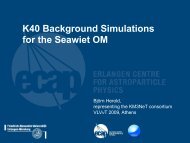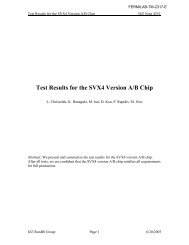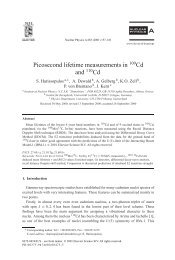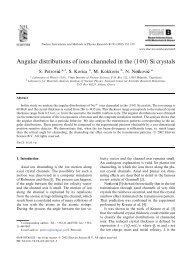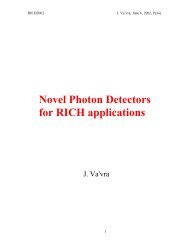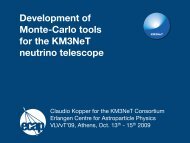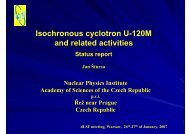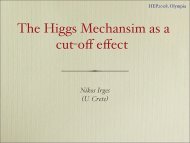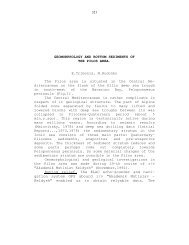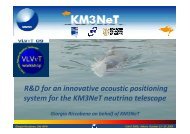"Operation and performance of the NESTOR test detector" Nucl.Instr ...
"Operation and performance of the NESTOR test detector" Nucl.Instr ...
"Operation and performance of the NESTOR test detector" Nucl.Instr ...
Create successful ePaper yourself
Turn your PDF publications into a flip-book with our unique Google optimized e-Paper software.
ARTICLE IN PRESS<br />
G. Aggouras et al. / <strong>Nucl</strong>ear <strong>Instr</strong>uments <strong>and</strong> Methods in Physics Research A 552 (2005) 420–439 435<br />
Fig. 15. Global arrival time distribution <strong>of</strong> <strong>the</strong> accumulated photoelectrons (solid points) compared with <strong>the</strong> Monte Carlo expectation<br />
(open circles) for events with six or more PMT pulses inside <strong>the</strong> trigger window.<br />
<strong>and</strong> arrival time resolution parameterized as a<br />
function <strong>of</strong> <strong>the</strong> pulse height for one <strong>of</strong> <strong>the</strong> pmts.<br />
7. Atmospheric muon studies<br />
Fig. 16. Measurement <strong>of</strong> <strong>the</strong> pulse amplitude dependence <strong>of</strong> <strong>the</strong><br />
bias (slewing) <strong>and</strong> <strong>the</strong> resolution in evaluating <strong>the</strong> pulse arrival<br />
time, using <strong>the</strong> collected calibration data during operation for a<br />
pmt. The continuous line is <strong>the</strong> parameterized function used in<br />
<strong>the</strong> in <strong>the</strong> track reconstruction analysis.<br />
From <strong>the</strong> total data sample collected with a 4-<br />
fold or higher coincidence trigger <strong>and</strong> 30 mV pmt<br />
threshold, a subset containing 45,800 events has<br />
been selected that have six or more pmt pulses<br />
(hits) within <strong>the</strong> 60 ns time window. These events<br />
have been analysed in order to reconstruct muon<br />
tracks. The arrival time <strong>of</strong> <strong>the</strong> digitized pmt pulses<br />
was used to estimate <strong>the</strong> muon track parameters<br />
by means <strong>of</strong> a w 2 fit whilst <strong>the</strong> pmt pulse heights<br />
were used to reject ghost solutions <strong>and</strong> poorly<br />
reconstructed tracks. The details <strong>of</strong> <strong>the</strong> reconstruction<br />
strategy <strong>and</strong> <strong>the</strong> relevant studies are reported<br />
in ano<strong>the</strong>r paper [30]. The results are summarized<br />
here.<br />
From <strong>the</strong> selected sample <strong>of</strong> events, 745 muon<br />
tracks have been reconstructed that have a<br />
perpendicular distance from <strong>the</strong> centre <strong>of</strong> <strong>the</strong><br />
detector (impact parameter) greater than 6 m.<br />
Fig. 17 shows <strong>the</strong> distribution <strong>of</strong> <strong>the</strong> azimuth<br />
angle <strong>of</strong> <strong>the</strong> reconstructed tracks. As expected, <strong>the</strong><br />
distribution in azimuth <strong>of</strong> <strong>the</strong> muon tracks at <strong>the</strong><br />
detector depth is not affected by <strong>the</strong> detector<br />
response or <strong>the</strong> reconstruction efficiency.<br />
The zenith angular distribution <strong>of</strong> <strong>the</strong> reconstructed<br />
tracks is compared to <strong>the</strong> Monte<br />
Carlo prediction in Fig. 18. Due to <strong>the</strong> limited



